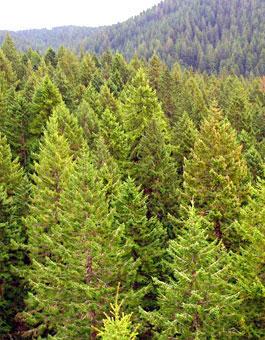

The undisputed champion of the building industry
Engineers marvel at its dimensional stability and strength. Architects and designers admire its close grain and the warmth, beauty and structural integrity it brings to a room. Floor to ceiling, you'll find Douglas-fir structural lumber and products in homes throughout the world. Its strength and availability in large dimensions make it outstanding for heavy-duty construction as well, such as trestles, bridges and commercial buildings. Millions of Douglas-fir Christmas trees are exported from Oregon each year.
Range
Douglas-fir trees are important as habitat for nesting birds, and decaying trees and snags are a key source of cavities for woodpeckers and other cavity nesters.
Character
A large, sun-loving conifer capable of living hundreds of years, attaining more than 200 feet in height and 10 feet in diameter.
Understory
Understories vary from dense to sparse depending on the availability of moisture, but are generally rich in shrubs and herbs. Douglas-fir is a long-lived, early- to mid-successional species. This means that it can colonize recently disturbed sites and continues to dominate them for hundreds of years.
Climate
Douglas-fir forests grow under a wide variety of conditions. The climate of west-side Douglas-fir forests ranges from wet and mild in the north to drier and warmer in the south. East-side Douglas-fir forests are drier than those of southwestern Oregon, and have more extreme temperature fluctuations both daily and seasonally.
Management
Prior to human management, Douglas-fir forests originated following large disturbances such as fire, landslides and windstorms, often resulting in patchy even-aged stands. Forest management practices such as clearcutting and shelterwood harvests, followed by planting and thinning, result in similar even-aged stands. Douglas-fir trees become commercially valuable around the age of 30 years. Rotation lengths range from 30 years to over a hundred years, depending on management objectives. In drier areas like southwestern and eastern Oregon, management practices can include individual tree and small-group selection harvests, resulting in uneven-aged stands.